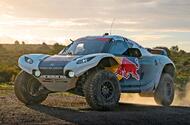Inside the new FIA Extreme H World Cup racers that will give FCEV tech its most challenging test yet
The hydrogen fuel cell could be one of the most highly developed and rigorously tested automotive technologies never to reach mainstream production, but that doesn’t mean it won’t.
The FIA Extreme H World Cup, a new off-road motorsport championship due to kick off later this year, aims to demonstrate just how capable the technology is.Â
Not only will its Pioneer 25 cars be powered by hydrogen fuel cells consuming sustainably produced hydrogen but the electricity powering on-site activities at the events will be generated using stationary fuel cells too.
The cars are based on Extreme E electric off-road racers, using the same kind of electric drivetrain but with the batteries partially replaced by a 75kW hydrogen fuel cell system. The stack is fuelled by 2kg of compressed hydrogen gas stored at 700 bar in two Toyota Mirai tanks.Â
Fuel cells are best suited to providing a steady stream of power rather than the transient bursts motors need, so there’s a 325kW, 36kWh battery in between the two, acting as a buffer.
Operating at 450V-850V, the battery powers two 268bhp motors driving front and rear axles and making 536bhp in total. Top speed is 124mph and 0-62mph takes 4.5sec, despite the car’s hefty 2200kg weight.
The fuel cell is supplied by Symbio but the aim is to allow teams to use their own fuel cell system if they wish.
Batteries come from Fortescue WAE, which opened a technical centre at Kidlington, Oxfordshire, in 2023 and also provided the batteries for Extreme E.
Extreme H batteries will be produced there too, but they have a slightly smaller capacity than those used in Extreme E, as the main power source is now the fuel cell.Â
As with Extreme E, the cars are manufactured by Spark Racing Technology, based at Tigery, outside Paris.Â
Each one is 6m long with a wheelbase of 3.2m (so roughly the same as a BMW 7 Series) and based on a tubular spaceframe chassis with front impact structures.Â
The Pioneer 25 passed its mandatory FIA chassis crash tests last year. Compared with an Extreme E car, the Pioneer 25 has a strengthened chassis, extra carbon-composite crash structures over the hydrogen tanks and energy-absorbing composite structures on either side of the car.Â
High- and low-pressure hydrogen systems were fitted during the tests and both were fully pressurised to ensure neither would lose any pressure.
The cars also completed FIA resilience tests for tanks and batteries before testing could take place, so the race series should be a useful demonstration of the robustness of fuel cell technology generally, given the pounding they will take.

